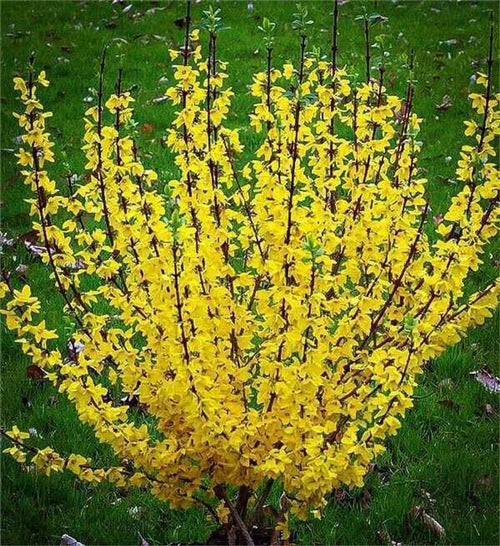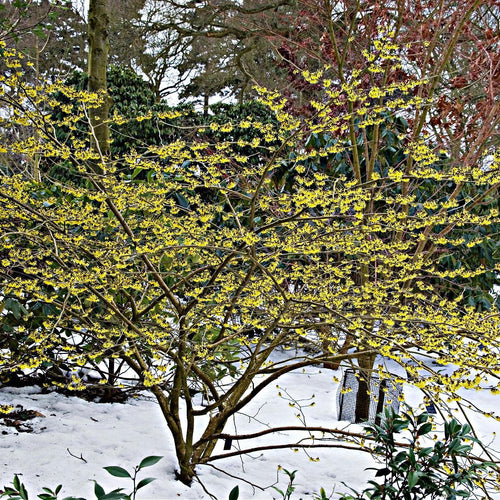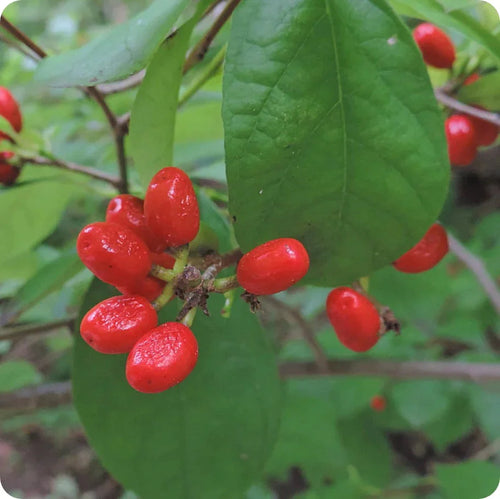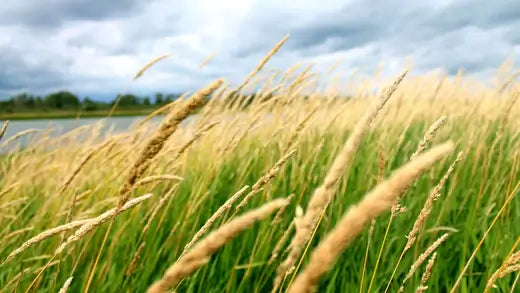Forsythia Intermedia Background
The forsythia intermedia is part of the olive family (Oleaceae). The forsythia genus has 11 species containing dozens of varieties and cultivars.
This plant was named after the Scottish botanist, William Forsyth. He was the director of the Royal Garden at Kensington and a founding member of the Royal Horticultural Society.
Native Range
The forsythia intermedia is native to Asia, namely China and Japan. It has been naturalized in southeastern Europe and North America in the past few hundred years.Growing Habits
Forsythia intermedia is a deciduous shrub that grows six to ten feet tall with a spread of eight to twelve feet. It is a fast and vigorous grower.
This shrub has rough brownish-grey bark and bears its flowers before its leaves. Because its stems grow naturally in an arching habit, it seldom needs to be pruned.
The forsythia intermedia does best in full sun and can tolerate some shade. If it receives too much shade, its stems will have a scraggly appearance and may not bloom as profusely.
This shrub is deer resistant and does not attract Japanese beetles.
USDA Hardiness Zones
Knowing your zone is important when selecting the right plant for your outdoor space. To figure out your zone, go to our home page and type in your zip code. There you will be shown exactly what zone you are in, no sign-up is required.
The forsythia intermedia can grow in zones five to eight. It can tolerate being grown in zone nine if given occasional shade and enough moisture.
This plant flowers in early spring before it grows leaves. The flower buds of the forsythia intermedia develop in fall and go dormant in winter. With enough warm days, forsythia intermedia will break dormancy and bloom. If the forsythia intermedia breaks dormancy but experiences a hard frost, the buds will die and the plant will not bloom that season.
Though forsythia intermedia are hardy, their tender buds may need protection from frost in late winter/early spring. This can be accomplished by covering the shrub with a woolen blanket or tarp.
Preferred Soil Conditions
Forsythia intermedia prefers a somewhat moist, free-draining soil. It can grow in soils that range from 6.0 to 8.0 pH. This shrub tolerates clay soils and can withstand alkaline soils. This shrub does not tolerate wet soil or excessive and prolonged periods of dryness.
Where to plant in the garden
This is a shrub that blooms for about two weeks in spring and shows off mellow, warm foliage colors in fall. It is an excellent shrub for beginning the momentum of succession planting.
Succession planting is planting perennials, shrubs, and trees that vary in blooming times. This type of planting allows for there to always be something blooming or at its peak in the garden throughout the year.
The forsythia intermedia can be grown in borders or hedges. It can fit in many gardening styles including spring gardens, Japanese gardens, and cottage gardens.
How to Grow
Growing forsythia is as easy as planting any shrub. Here is the process step-by-step:
- Select a location that receives plenty of sun throughout the day
- Forsythia intermedia can be planted anywhere but at the bottom of a hill. This area is more prone to standing water and receives more frost in spring
- Dig a hole just big enough to cover the roots and not the stem
- If in a container, make sure roots are growing around in a circle, if they are, tease them apart so they can grow outward and not around
- Gently backfill and firm in soil with your hands
- Water thoroughly to help the plant establish and to remove any air pockets in the soil
- Do not prune for the first year or two so the roots can fully establish
- Fertilize each fall with 10-10-10 fertilizer
How to Prune
- Forsythia intermedia can be left to grow naturally
- Broken or crossing branches should be removed to minimize disease potential
- It can be lightly pruned by cutting back 20-30% of the branches at the base, this will thin it out and allow more light into the center
- If very unruly or overgrown, it can be pruned within 3 to 4 inches of the ground, this can be done every four years to rejuvenate it
How to Propagate
Propagation can be done in two different ways: by layering or by cuttings.
Layering
This means taking one of its low-hanging branches to the ground without cutting or breaking it. The stem, in contact with the soil, will form roots. After several months or when there are enough roots, the branch can be cut away from the parent shrub. You can dig up the new plant or let it grow where it is.
Taking Cuttings
The second method of taking cuttings is very similar. Take a cutting of about six inches with the diameter of a pencil. Dip the cut end of the stem into rooting hormone if you have it, and insert it into a small container of potting soil. Water the plant regularly and plant once roots are visible, this may take up to a year.
Forsythia intermedia for sale
With its bright yellow flowers, the forsythia intermedia is the harbinger of spring. It is one of the most striking spring shrubs with the benefit of being easy to grow. It blooms in early spring for two weeks and then grows its foliage. In fall, leaves fade from green to gold for another beautiful seasonal display.
Zone: 5 to 8
Sun: Full sun to part shade
Mature Height: 6 to 10 feet
Water: Average
Best for use as a hedge or in cottage and spring gardens
Buy Forsythia Intermedia here
Similar Shrubs
These shrubs are similar to the forsythia intermedia in their color, growth habit, or striking color. They all grow in similar conditions to the forsythia and can be used for succession planting.
Witch Hazel
Witch hazel also has a beautiful yellow color, except it is most vibrant in the fall. This shrub makes an excellent screen to create a sense of privacy on your property. Because it is deciduous, it will lose its leaves in winter and regrow them in spring.
Zone: 3 to 8
Sun: Full sun to part shade
Mature Height: up to 25 feet
Water: Average
Best for use as a hedge or privacy screen
Buy Witch Hazel here
Northern Spice Bush
This deciduous shrub can grow up to 15 feet. It grows best in rich, well-draining soils. Like the witch hazel, the northern spice bush has the best colored foliage in fall. It gets its name from its enchanting, spicy fragrance.
Zone: 6 to 9
Sun: Full sun
Mature Height: up to 15 feet
Water: Average
Best for use as a hedge or privacy screen
Buy Northern Spice Bush here
Coral Red Dogwood
The coral red dogwood does not have yellow flowers or foliage. Instead, it has green foliage, white blossoms, and red berries. Best of all, it shows off bright, red stems from late fall throughout winter. This brings much-needed color to the otherwise dull winter garden.
Zone: 3 to 9
Sun: Full sun
Mature Height: up to 5 feet
Water: Average
Best for a hedge or in winter gardens
Buy the Coral Red Dogwood shrub here
Whether you are looking to add color to a late spring garden or just want a privacy screen, the forsythia intermedia makes an excellent choice. With it being such a low-maintenance shrub, it is a great option for the novice gardener and seasoned gardener alike.
If you have any more questions about the forsythia intermedia or any other shrubs, please feel free to reach out!




















































